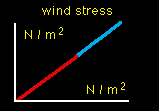

Exercise 2 introduced the concept of scalars such as temperature and salinity and vectors such as ocean currents. This exercise demonstrates methods for calculating slowly varying means of vector quantities. Such calculations are required to extract, for example, the daily mean wind from measurements taken at short intervals (a few minutes or so) that contain the variability of wind gusts and turbulence. The exercise will also demonstrate why it is necessary to make such observations at short time intervals, even if the quantity of interest is only the daily mean.
One instance where measurements at high resolution in time are a necessity is the determination of wind stress. Wind stress is a quadratic function of the wind velocity. Although the quadratic dependence is derived from theoretical concepts, the actual formula which relates the wind stress τ to wind velocity is found empirically and, loosely speaking, takes the form
wind stress (τ) = (drag coefficient) x (air density) x (wind speed squared) *


The figure on the side demonstrates the effect of the second power dependence of wind stress on wind speed: A small increase in wind speed produces a significant increase in wind stress. What this means is that the squalls and wind bursts contribute most to the wind stress, and a wind stress calculation can only give good results if it includes the gusts and squalls.
This exercise will demonstrate the steps required to derive wind stress from wind measurements. It begins with artificial wind data designed to simulate the situation in the Trade Wind region and in the region of the Westerlies. Actual observations will be used later in the exercise.
* The exact form of this equation and the units for wind stress (Newtons per square meter or N m-2) will be discussed later in this exercise.